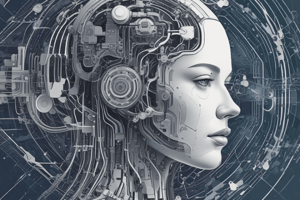Podcast
Questions and Answers
What is the primary purpose of computer vision in artificial intelligence?
What is the primary purpose of computer vision in artificial intelligence?
- To teach computers to recognize patterns in text
- To improve the accuracy of machine translation between languages
- To develop more advanced speech recognition algorithms
- To enable computers to understand and process complex images and video (correct)
Which of the following AI techniques is used to locate and classify individual objects within a scene?
Which of the following AI techniques is used to locate and classify individual objects within a scene?
- Image segmentation
- Object detection (correct)
- Speech recognition
- Facial recognition
How do facial recognition algorithms work in artificial intelligence?
How do facial recognition algorithms work in artificial intelligence?
- By comparing facial features to known templates to match individuals to their respective profiles (correct)
- By using speech recognition to identify individuals based on their voices
- By using object detection to identify individuals based on their body shape and size
- By analyzing the text in images to determine the identity of individuals
What is the primary goal of image segmentation in artificial intelligence?
What is the primary goal of image segmentation in artificial intelligence?
Which of the following AI techniques is most closely related to the development of natural language processing (NLP) systems?
Which of the following AI techniques is most closely related to the development of natural language processing (NLP) systems?
Which of the following AI techniques is most commonly used in the development of self-driving car technology?
Which of the following AI techniques is most commonly used in the development of self-driving car technology?
What type of neural networks are designed for computer vision tasks like object recognition and classification?
What type of neural networks are designed for computer vision tasks like object recognition and classification?
Which type of learning enables computers to automatically improve with experience without explicit programming?
Which type of learning enables computers to automatically improve with experience without explicit programming?
What subset of AI focuses on developing programs that access external data and adjust parameters based on feedback?
What subset of AI focuses on developing programs that access external data and adjust parameters based on feedback?
Which type of neural networks allows for longer range dependencies and is suitable for modeling data with temporal relationships?
Which type of neural networks allows for longer range dependencies and is suitable for modeling data with temporal relationships?
Which algorithmic technique does not require labeled training data?
Which algorithmic technique does not require labeled training data?
What allows machines to learn representations of data with minimal human supervision?
What allows machines to learn representations of data with minimal human supervision?
Flashcards are hidden until you start studying
Study Notes
Artificial Intelligence
Artificial intelligence (AI) has its roots in the 1950s when researchers from diverse fields began to build machines capable of performing tasks requiring human-like intelligence. AI is designed to replicate tasks that would normally require human intervention, such as visual perception, speech recognition, decision-making, and translation between languages.
Major subfields of AI include:
-
Computer Vision: Computer vision involves teaching computers to recognize patterns in images and video. By using various techniques like image normalization and object detection, computers can process complex images and identify objects within them.
-
Object Detection: Object detection algorithms enable computers to locate and classify individual objects within a scene. This technology is widely used in applications like self-driving cars and surveillance systems.
-
Facial Recognition: Facial recognition algorithms help computers identify individuals from image and video feeds. These systems work by comparing facial features to known templates, allowing them to match individuals to their respective profiles. Facial recognition has gained popularity in security applications and photo tagging services.
-
Image Segmentation: Image segmentation involves dividing an image into multiple sections where each section contains pixels representing the same object or material. This technique helps improve object tracking and scene interpretation by enabling computers to distinguish objects from backgrounds.
-
-
Deep Learning: Deep learning is a subset of machine learning that uses artificial neural networks with representation learning. Representation learning allows machines to learn representations of data with no or minimal human supervision.
-
Convolutional Neural Networks (CNNs): CNNs are designed for computer vision tasks like object recognition and classification. They work by applying filters to input images in convolution layers. These filters detect patterns within the images, helping to classify objects.
-
Recurrent Neural Networks (RNNs): RNNs are designed for sequence processing, such as speech recognition and language translation. They maintain hidden states, which enable them to process sequential data. By keeping track of previous inputs, RNNs can recognize patterns within sequences.
-
-
Neural Networks: Neural networks are algorithms inspired by the structure and function of biological neurons. They consist of interconnected nodes that send and receive signals. These networks can be trained to perform complex computational tasks, such as pattern matching and optimization problems.
-
Feedforward Neural Networks (FNNs): FNNs are commonly used for simple single-step predictions, such as estimating the probability of a given event. They operate by passing input data through a series of connected layers until a final output is produced.
-
Long Short-Term Memory (LSTM) Networks: LSTM networks are a type of recurrent neural network. They allow for longer range dependencies and are therefore suitable for modeling data with temporal relationships.
-
-
Machine Learning: Machine learning is a subset of AI that focuses on developing programs capable of accessing external data and changing parameters based on feedback. It enables computers to automatically improve with experience without explicit programming.
-
Supervised Learning: Supervised learning algorithms require labeled training data, meaning the correct answers are provided. Common supervised learning techniques include k-nearest neighbors (kNN) and support vector machines (SVMs).
-
Unsupervised Learning: Unsupervised learning algorithms don't require labeled data. Instead, they search for patterns in data. Examples include clustering and anomaly detection.
-
Artificial intelligence continues to evolve rapidly, with ongoing advancements in areas like reinforcement learning, autonomous systems, and robotics. As our ability to teach computers to think and reason improves, the potential for AI to revolutionize industries and transform society becomes increasingly evident.
Studying That Suits You
Use AI to generate personalized quizzes and flashcards to suit your learning preferences.




